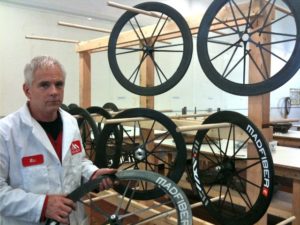Regarding our recent post on Mad Fiber’s revolutionary new “holistically engineered” carbon-fiber wheels, Ron George over at Cycling Bee quotes wheel-building legend Jobst Brandt to the effect that carbon in wheels is too fraught with peril:
“Meanwhile, another respected engineer Jobst Brandt told me that the whole idea of a non-heat absorbing rim is nuts. He saw a collapsed carbon fiber wheel in Italy and did not like the stress problems in the spokes. “I think he is more into the art of the wheels than function in manufacture, building and performance,” he remarked [about Ric Hjertberg]. Yes, carbon fiber’s strength-to-weight ratio is off the chart but I do have to consider Jobst’s comments. How well do people know carbon fiber anyway? The engineers behind the new Boeing 787 Dreamliner, built with 50 percent carbon composites, can’t even accurately predict how the structure will behave in the event of a crash. Other experienced engineers remain uneasy in spite of the fancy imagery their computers show them. The material’s true value can be overrated when kept in context with its price.” [Full post here.]
Rim failure from overheating is hardly unique to carbon, however. In our callow youth we once blew out an aluminum rim coming down viciously steep Alba Road above Santa Cruz on a 95-degree day.
All that said, we nonetheless were curious about Mad Fiber founder Ric Hjertberg’s response to Jobst’s challenge. (As a side note, these guys know each other well. Back in the day we often ran into Jobst at Ric’s Wheelsmith shop in Palo Alto.)
In an email, Ric offered up his defense. Anyone who knows Ric understands he’s as articulate as they come, so what follows is a minimally edited version of his original email.
First off, Ric makes it clear (and we would second him) that he’s no starry-eyed fiber groupie. “I doubt there’s a perfect bicycle or component design,” he notes. “Certainly, the classic tubular metal diamond with wire wheels, pneumatic tires, and chain drive is a timeless stroke of genius. But it’s a human invention — not a given, like rain.”
What does set Ric and other bike-engineering pioneers (Gary Fisher and Charlie Cunningham are leading examples) apart is their insistence on continuing to innovate. Despite accomplished careers where they reached the pinnacle of their profession, these guys still think there’s work to be done for improving the cycling experience.
As Ric put it, “I recommend we 1) Try and better understand the bicycle’s function, a lofty task, 2) Enjoy and expand our riding, 3) Share the joy of pedaling, and 4) experience the varieties of cycling.”
In other words, no matter how much mileage we have on our tires, let’s keep pinning the fun meter!
To that end, composites bring a whole new aspect to biking. “Cycling’s pioneers attacked the issues of efficiency, weight, durability, aerodynamics, safety, comfort, and beauty with a ferocious determination,” Ric notes. The hallowed names of Colnago and Cinelli and even Schwinn “certainly would have made extensive use of composites, were they available. Reckless, ambitious, challenging? Yes indeed. They pushed the limits in every possible way.”
Variety itself “with bicycles, like art or food, is part of the fun,” Ric says. “Carbon wheels are not ‘better’ than wood or aluminum any more than dirt is better than pavement or ale better than stout. Folks should try stuff out and judge for themselves.” And while “ill-advised uses” of carbon exist in cycling, they’re no different from other materials. Bottom line: “Composites are here to stay.”
Regarding carbon wheels in particular, Ric notes that they are late coming to the carbon-component game, which means they’re still young in their development cycle. “In the early days of suspension forks, there were many obvious shortcomings and skeptics. Carbon wheels will eventually sort it out.”
In terms of brake heat, then? Ric acknowledges that “carbon rims have serious issues with it.” Disc brakes (de rigueur on mountain bikes and getting that way for comfort, commuter and folding bikes) ultimately will solve the issue. “Perhaps the way carbon wheels renewed the popularity of sew ups will also apply to the adoption of disk brakes. Stranger things have happened,” Ric notes.
And what about the ever-colorful, imperiously opinionated Jobst? “His “opinions are always a welcome addition” Ric says, adding that Jobst is a “gifted, out-of-the-box thinker.” It’s important to note, though, that Jobst’s engineering career “predates” the carbon-fiber revolution.
“I doubt he will represent himself as a composites expert,” Ric concludes.
In any case, with dialog being the No. 1 piston for the engine of innovation, Ric says to keep the communication channels open.
“More than ever, we need sage advice on the costs and benefits of high technology,” he notes. While carbon is “not for everyone,” it’s paramount to “keep the conversation going!”

Paul,
Thanks for having Ric follow up. He does have a point in stating that carbon fiber is well after Jobst’s time. He does however have an unmatched expertise in mechanical knowledge and I wouldn’t necessarily ignore his advice, whatever they might be. Let’s get the dialog going. Gives me another chance to talk to Jobst!
How refreshing and uncommon to see two technological ‘adversaries’ discussing their points intelligently, respectfully and with good grace. We need more like ’em and not just for what they can contribute technically.